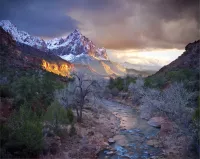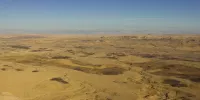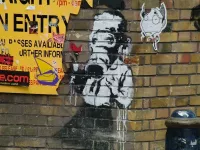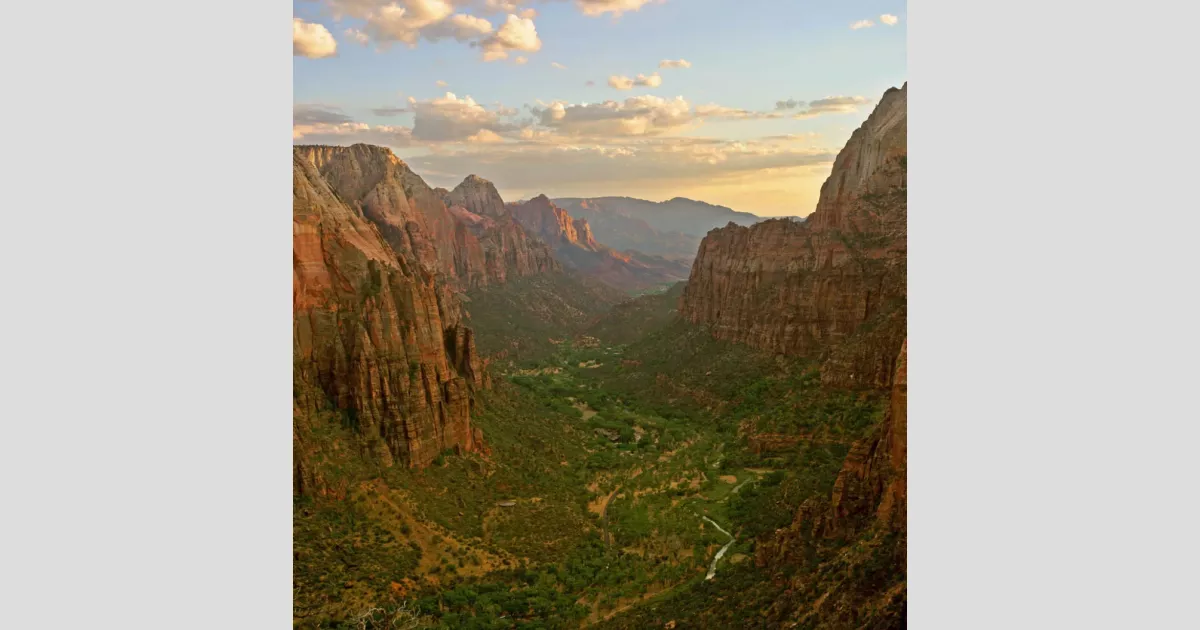Zion National Park, situated in southwestern Utah near Springdale, lies at the convergence of the Colorado Plateau, Great Basin, and Mojave Desert, resulting in diverse ecosystems. This unique geography supports a wide array of flora and fauna, including 289 bird species, 75 mammals, and 32 reptiles, distributed across four life zones. The park encompasses a varied landscape of mountains, canyons, mesas, rivers, and natural arches. Zion Canyon, a major feature, stretches 15 miles long and reaches depths of up to 2,640 feet, carved by the Virgin River into reddish Navajo Sandstone. In 2023, the park attracted 5 million visitors.
1900: Cableworks Built on East Rim Trail
In 1900, David Flanigan built cableworks on the improved Native American footpath up Echo Canyon (later the East Rim Trail) to lower lumber into Zion Canyon.
1904: Paintings Exhibited at Saint Louis World's Fair
In 1904, Frederick S. Dellenbaugh's paintings of the canyon were exhibited at the Saint Louis World's Fair.
1906: Lumber Lowered by Cableworks
By 1906, more than 200,000 board feet of lumber had been lowered by the cableworks into Zion Canyon.
July 31, 1909: Mukuntuweap National Monument Created
On July 31, 1909, President William Howard Taft created Mukuntuweap National Monument.
1909: Mukuntuweap National Monument Established
In 1909, President William Howard Taft named the area Mukuntuweap National Monument to protect the canyon.
1909: Farming Ends as Zion Becomes a Monument
In 1909, the canyon floor was farmed until Zion became a Monument.
1910: Road Upgrades Begin
Around 1910, old wagon roads began to be upgraded to the first automobile roads in southern Utah.
1917: Touring Cars Reach Zion Canyon
By the summer of 1917, touring cars could reach Zion Canyon, and the first visitor lodging, Wylie Camp, was established as a tent camp.
1917: Name Change Proposed
In 1917, the acting director of the National Park Service proposed changing the name from Mukuntuweap to Zion.
1917: Road to Zion Canyon Built
In 1917, the road into Zion Canyon was built leading to the Grotto.
1918: Proposal to Change Name to Zion National Monument
In 1918, Horace Albright, acting director of the National Park Service, proposed enlarging the monument and changing its name to Zion National Monument.
November 19, 1919: Zion National Park Established
On November 19, 1919, Congress redesignated the monument as Zion National Park, and President Woodrow Wilson signed the act.
1923: Utah Parks Company Acquires Wylie Camp
In 1923, the Utah Parks Company, a subsidiary of the Union Pacific Railroad, acquired Wylie Camp and offered tours to Zion, Bryce Canyon, the Kaibab Plateau, and the Grand Canyon.
1924: The Deadwood Coach Film
In 1924, Zion National Park was featured in the film The Deadwood Coach.
1925: Zion Lodge Built
In 1925, the Zion Lodge complex was built at the site of the Wylie tent camp, designed by architect Gilbert Stanley Underwood and funded by the Utah Parks Company.
1926: Angel's Landing Trail Constructed
In 1926, Angel's Landing Trail was constructed, and two suspension bridges were built over the Virgin River.
1927: Zion - Mount Carmel Highway Construction Starts
In 1927, work started on the Zion – Mount Carmel Highway to improve access between Springdale and the east side of the park.
1930: Zion - Mount Carmel Highway Opens
In 1930, the Zion – Mount Carmel Highway opened, increasing park visits and travel in the area.
January 22, 1937: Kolob Canyons Proclaimed Zion National Monument
On January 22, 1937, the Kolob Canyons area was proclaimed as a separate Zion National Monument.
1937: Kolob Section Proclaimed a Separate Zion National Monument
In 1937, the Kolob section was proclaimed a separate Zion National Monument.
1947: Ramrod Film
In 1947, Zion National Park was featured in the film Ramrod.
July 11, 1956: Kolob Canyons Incorporated into Zion National Park
On July 11, 1956, the Kolob Canyons area was incorporated into Zion National Park.
1956: Kolob Section Incorporated into Zion National Park
In 1956, the Kolob section was incorporated into Zion National Park.
1969: Butch Cassidy and the Sundance Kid Film
In 1969, Zion National Park was featured in the film Butch Cassidy and the Sundance Kid.
1973: Desert Bighorn Sheep Reintroduced
In 1973, desert bighorn sheep were reintroduced in Zion National Park.
April 12, 1995: Landslide Blocks Virgin River
On April 12, 1995, heavy rains triggered a landslide that blocked the Virgin River in Zion Canyon, trapping guests and employees at the Zion Lodge.
May 25, 1995: Temporary Road Constructed
On May 25, 1995, a more stable temporary road was completed to allow summer visitors to access Zion Canyon after the landslide.
1996: Permanent Road Replaces Temporary Road
In 1996, the temporary road was replaced with a permanent road in Zion Canyon.
2000: Public Transportation System Instituted
In the year 2000, a public transportation system using propane-powered shuttle buses was instituted in Zion Canyon due to traffic congestion.
2007: Start of Recorded Death Toll
Since 2007, there have been 60 recorded deaths in Zion National Park, mainly due to falls, heat-related illnesses, and flash floods.
March 2009: Omnibus Public Land Management Act Signed
In March 2009, President Barack Obama signed the Omnibus Public Land Management Act of 2009, designating approximately 85% of Zion National Park as the Zion Wilderness.
2009: Wilderness Area Designated
In 2009, Congress designated 85% of Zion National Park as a wilderness area.
2011: Zion Featured in Fallout: New Vegas DLC
In 2011, Zion National Park was featured in the Honest Hearts downloadable content pack for the game Fallout: New Vegas.
2014: First Condor Breeding Confirmed
In 2014, the first successful breeding of California condors in Zion National Park was confirmed.
September 2015: Flooding in Keyhole Canyon
In September 2015, a flash flood trapped a group of seven in Keyhole Canyon, resulting in the deaths of all members after a multi-day search.
2017: Scenes from Extinct Shot in Park
In 2017, some scenes from the TV series Extinct were shot in Zion National Park.
March 25, 2020: Campgrounds Closed Due to COVID-19
On March 25, 2020, the park campgrounds were closed to help prevent the spread of COVID-19.
2023: Zion Attracts 5 Million Visitors
In 2023, Zion National Park attracted 5 million visitors.
February 2, 2024: Hiker Death on Trail
On February 2, 2024, a hiker died after falling while on a steep trail in Zion National Park.
Mentioned in this timeline

Barack Obama the th U S President - was the...
California is a U S state on the Pacific Coast...
Arizona is a landlocked state in the Southwestern U S...

The Virgin River is a -mile-long tributary of the Colorado...

A desert is a landscape characterized by minimal precipitation leading...
Nevada a landlocked state in the Western US is the...
Trending

6 months ago Venice Preserves Banksy's Migrant Mural with Scaffolding to Protect Artwork.

Robert Hunter Biden is an American attorney and businessman son of former President Joe Biden He co-founded BHR Partners a...
2 months ago John Bolton faces potential indictment as federal prosecutors finalize charges next week.
21 days ago Snowstorm Expected to Hit Philadelphia and Pittsburgh on Tuesday: Forecast Details
2 months ago Six missing children found safe in Lancaster County after search by police.

2 months ago Halle Berry, 59, Celebrates Coastal Getaway in Stunning Bikini, Drawing Fan Acclaim.
Popular

Tucker Carlson is an American conservative political commentator known for...

Candace Owens is an American conservative political commentator and author...

XXXTentacion born Jahseh Dwayne Ricardo Onfroy was a controversial yet...

Ben Shapiro is a prominent American conservative political commentator media...

William Franklin Graham III commonly known as Franklin Graham is...

Bill Gates an American businessman and philanthropist revolutionized personal computing...
